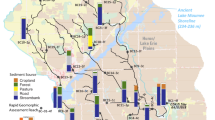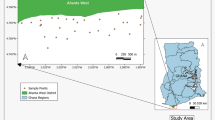Abstract
Sedimentation and remobilization processes of radiocesium were investigated from time-series observations at nine stations in the coastal area of Ibaraki, 70–110 km south of the Fukushima Dai-ichi Nuclear Power Plant (1FNPP). Sediment samples were collected four times between June 2011 and January 2012, and concentrations of radiocesium as well as sediment properties such as grain size and elemental compositions were analyzed. Cumulative inventory of 137Cs in sediment (0–10 cm) ranged between 4 × 103 and 3 × 104 Bq/m2 as of January 2012. This amount was generally higher at stations nearer 1FNPP and has remained at the same level since August 2011. From these results, it can be inferred that dissolved radiocesium advected southward from the region adjacent to the 1FNPP and was deposited to the sediment of the study area in the early stage after the accident. The incorporation of radiocesium into sediments was almost irreversible, and higher concentrations of 137Cs were obtained from the finer-grained fraction of sediments. In the northern offshore stations, resuspension of the fine-grained sediments formed a high-turbidity layer 10–20 m above the seabed. These results indicate that radiocesium-enriched fine particles were transported from the coast to offshore regions through the bottom high-turbidity layer.







Similar content being viewed by others
References
Abril, J. M., & Fraga, E. (1996). Some physical and chemical features of the variability of Kd distribution coefficients for radionuclides. Journal of Environmental Radioactivity, 30, 253–270.
Aoyagi, K., & Igarashi, C. (1999). On the size distribution of sediments in the coastal sea of Fukushima Prefecture. Bulletin of the Fukushima Prefectural Fisheries Experimental Station, 8, 69–81 (in Japanese).
Aoyama, M., Tsumune, D., & Hamajima, Y. (2012). Distribution of 137Cs and 134Cs in the North Pacific Ocean: impacts of the TEPCO Fukushima-Daiichi NPP accident. Journal of Radioanalitical Nuclear Chemistry. doi:10.1007/s10967-012-2033-2.
Buesseler, K. O., Aoyama, M., & Fukasawa, M. (2011). Impacts of the Fukushima Nuclear Power Plants on marine radioactivity. Environmental Science and Technology, 45, 9931–9935.
Buesseler, K. O., Jayne, S. R., Fisher, N. S., Rypina, I. I., Baumann, H., Baumann, Z., et al. (2012). Fukushima-derived radionuclides in the ocean and biota off Japan. Proceedings of the National Academy of Science, 109, 5984–5988.
Bustamante, P., Teyssie, J. L., Fowler, S. W., & Warnau, M. (2006). Assessment of the exposure pathway in the uptake and distribution of americium and cesium in cuttlefish (Sepia officinalis) at different stages of its life cycle. Journal of Experimental Marine Biology and Ecology, 331, 198–207.
Comans, R. N. J., & Hockley, D. (1992). Kinetics of cesium sorption on illite. Geochimica et Cosmochimica Acta, 56, 1157–1164.
Comans, R. N. J., Haller, M., & DePreter, P. (1991). Sorption of cesium on illite: non-equilibrium behavior and reversibility. Geochimica et Cosmochimica Acta, 55, 433–440.
JFA (Japan Fisheries Agency) (2011). http://www.jfa.maff.go.jp/e/inspection/pdf/201103-09_kekka_en.pdf. Accessed on May 16, 2012.
Fukui, M. (1988). Uptake of radionuclides onto suspended particulate matter in coastal water. Journal of Nuclear Science and Technology, 25, 934–942.
Hanawa, K., & Mitsudera, H. (1987). Variation of water system distribution in the Sanriku coastal area. Journal of the Oceanographic Society of Japan, 42, 435–446.
Hirose, K. (2012). Fukushima Dai-ichi nuclear power plant accident: summary of regional radioactive deposition monitoring results. Journal of Environmental Radioactivity, 111, 13–17.
Hjulstrøm, F. (1935). Studies of the morphological activity of rivers as illustrated by the River Fyris. Bulletin of the Geological Institution of the University of Upsala, 25, 221–527.
Ito, T., Otosaka, S., & Kawamura, H. (2007). Estimation of total amounts of anthropogenic radionuclides in the Japan Sea. Journal of Nuclear Science and Technology, 44, 912–922.
Kasamatsu, F. (1999). Marine organisms and radionuclides—with special reference to the factors affecting concentration of 137Cs in marine fish. Radioisotopes, 48, 266–282 (In Japanese).
Kawamura, H., Kobayashi, T., Furuno, A., In, T., Ishikawa, Y., Nakayama, T., et al. (2011). Preliminary numerical experiments on oceanic dispersion of 131I and 137Cs discharged into the ocean because of the Fukushima Daiichi Nuclear Power Plant disaster. Journal of Nuclear Science and Technology, 48, 1349–1356.
Kubo, H. (1988). Research on the oceanographic conditions of Kashima-Nada, off the east coast of Honshu. Bulletin of the Ibaraki Prefectural Fisheries Experimental Station, 26, 1–98 (in Japanese with English summary and captions).
Lujanienė, G., Vilimaitė-Šilobritienė, B., & Jokšas, K. (2005). Accumulation of 137Cs in bottom sediments of the Curonian Lagoon. Nucleonika, 50, 23–29.
Matsunaga, T., Amano, H., & Yanase, N. (1991). Discharge of dissolved and particulate 137Cs in the Kuji River, Japan. Applied Geochemistry, 6, 159–167.
MEXT (2011a). http://radioactivity.mext.go.jp/en/contents/4000/3325/24/1305745_0527.pdf. Accessed on July 2, 2012.
MEXT (2011b). http://radioactivity.mext.go.jp/en/contents/4000/3324/24/1305745_0612.pdf. Accessed on July 2, 2012.
MEXT (2011c). http://radioactivity.mext.go.jp/en/contents/4000/3331/24/1350_1108.pdf. Accessed on July 2, 2012.
MEXT (2011d). http://radioactivity.mext.go.jp/en/contents/4000/3312/24/1304193_0331.pdf. Accessed on July 2, 2012.
MEXT (2012a). Database of environmental radioactivity. http://search.kankyo-hoshano.go.jp. Accessed on July 2, 2012 (in Japanese).
MEXT (2012b). http://radioactivity.mext.go.jp/en/contents/4000/3334/24/1350_012514.pdf. Accessed on July 2, 2012.
MEXT (2012c). http://radioactivity.mext.go.jp/en/contents/4000/3285/24/1330_030114.pdf. Accessed on July 2, 2012.
MEXT (Ministry of Education, Culture, Sports, Science and Technology) (2004). Gamma-ray spectrometry using a germanium detector. Radioactivity Measurement Series No. 7. Tokyo: Ministry of Education, Culture, Sports, Science and Technology (In Japanese).
MLIT (Ministry of Land, Infrastructure and Transport, Japan). (2012). River discharges year book of Japan, year 2007. Tokyo: Japan River Association.
MOE (Ministry of Environment, Japan) (2011). http://www.env.go.jp/jishin/monitoring/result_pw111202.pdf. Accessed on July 2, 2012.
Mortlock, R. A., & Froelich, P. N. (1989). A simple method for the rapid determination of biogenic opal in pelagic marine sediments. Deep Sea Research, 36, 1415–1426.
Nagano, T., Yanase, N., Tsuduki, K., & Nagao, S. (2003). Particulate and dissolved elemental loads in the Kuji River related to discharge rate. Environment International, 28, 649–658.
Nagaya, Y., & Saiki, M. (1967). Accumulation of radionuclides in coastal sediment of Japan (I) fallout radionuclides in some coastal sediments in 1964–1965. Journal of Radiation Research, 8, 37–43.
Nasu, N. (1964). The provenance of the coarse sediments on the continental shelves and the trench slopes off the Japanese Pacific coast. In R. L. Miller (Ed.), Papers in marine geology (pp. 65–101). New York: Macmillan Co.
Nyffeler, U. P., Li, Y. H., & Santschi, P. H. (1984). A kinetic approach to describe trace-element distribution between particles and solution in natural aquatic systems. Geochimica et Cosmochimica Acta, 48, 1513–1522.
Otosaka, S., Togawa, O., Baba, M., Karasev, E., Volkov, Y. N., Omata, N., et al. (2004). Lithogenic flux in the Japan Sea measured with sediment traps. Marine Chemistry, 91, 143–163.
Otosaka, S., Amano, H., Ito, T., Kawamura, H., Kobayashi, T., Suzuki, T., et al. (2006). Anthropogenic radionuclides in sediment in the Japan Sea: distribution and transport processes of particulate radionuclides. Journal of Environmental Radioactivity, 91, 128–145.
Poinssot, C., Baeyens, B., & Bradbury, M. H. (1999). Experimental and modeling studies of caesium sorption on illite. Geochimica et Cosmochimica Acta, 63, 3217–3227.
Sakuma, H., & Kawamura, K. (2011). Structure and dynamics of water on Li+-, Na+-, K+-, Cs+-, H3O+-exchanged muscovite surfaces: a molecular dynamics study. Geochimica et Cosmochimica Acta, 75, 63–81.
Santschi, P. H., Bower, P., Nyffeler, U. P., Azevedo, A., & Broecker, W. S. (1983). Estimates of the resistance to chemical transport posed by the deep-sea boundary layer. Limnology and Oceanography, 28, 899–912.
Santschi, P. H., Bollhalder, S., Zingg, S., Lueck, A., & Farrenkothen, K. (1990). The self-cleaning capacity of surface waters after radioactive fallout. Evidence from European waters after Chernobyl, 1986–1988. Environmental Science and Technology, 24, 519–527.
Seibold, E., & Berger, W. H. (1993). Deep-sea sediments—patterns, processes, and stratigraphic methods. In E. Seibold & W. H. Berger (Eds.), The sea floor (pp. 215–240). Berlin: Springer.
Spencer, D. W., Robertson, D. E., Turekian, K. K., & Folsom, T. R. (1970). Trace element calibrations and profiles at the GEOSECS test station in the northeast Pacific Ocean. Journal of Geophysical Research, 75, 7688–7696.
Tsumune, D., Tsubono, T., Aoyama, M., & Hirose, K. (2012). Distribution of oceanic 137Cs from the Fukushima Dai-ichi Nuclear Power Plant simulated numerically by a regional ocean model. Journal of Environmental Radioactivity, 111, 100–108.
USEPA (United States Environmental Protection Agency). (1999). Understanding variation in partition coefficient, Kd, values Vol. II: review of geochemistry and available Kd values for cadmium, cesium, chromium, lead, plutonium, radon, strontium, thorium, tritium (3H), and uranium. EPA 402-R-99-004B. Washington: Office of Air and Radiation, US Environmental Protection Agency.
Yamada, M. (1997). 239+240Pu and 137Cs concentrations in salmon (Oncorhynchus keta) collected on the Pacific coast of Japan. Journal of Radioanalytical and Nuclear Chemistry, 223, 145–148.
Yeager, K. M., Santschi, P. H., & Rowe, G. T. (2004). Sediment accumulation and radionuclide inventories (239,240Pu, 210Pb and 234Th) in the northern Gulf of Mexico, as influenced by organic matter and macrofaunal density. Marine Chemistry, 91, 1–14.
Acknowledgments
Field and analytical supports were provided by staff members of Radiation Protection Department, Nuclear Fuel Cycle Engineering Lab., JAEA. This investigation benefited enormously and was vastly improved through discussions with Drs. M. Chino, A. Endo, O. Togawa, H. Nagai, T. Matsunaga, H. Kawamura, T. Suzuki (JAEA), S. Igarashi (Fukushima Pref.), Y. Kato, and H. Narita (Tokai University). We are also grateful to two anonymous reviewers for their constructive comments on the paper.
Author information
Authors and Affiliations
Corresponding author
Appendix
Appendix
Rights and permissions
About this article
Cite this article
Otosaka, S., Kobayashi, T. Sedimentation and remobilization of radiocesium in the coastal area of Ibaraki, 70 km south of the Fukushima Dai-ichi Nuclear Power Plant. Environ Monit Assess 185, 5419–5433 (2013). https://doi.org/10.1007/s10661-012-2956-7
Received:
Accepted:
Published:
Issue Date:
DOI: https://doi.org/10.1007/s10661-012-2956-7




